Content
All issues / Volume 16 (2022) / Issue 8 (August)
Jordi Puiggali
Vol. 16., No.8., Pages 785-785, 2022
DOI: 10.3144/expresspolymlett.2022.57
Vol. 16., No.8., Pages 785-785, 2022
DOI: 10.3144/expresspolymlett.2022.57
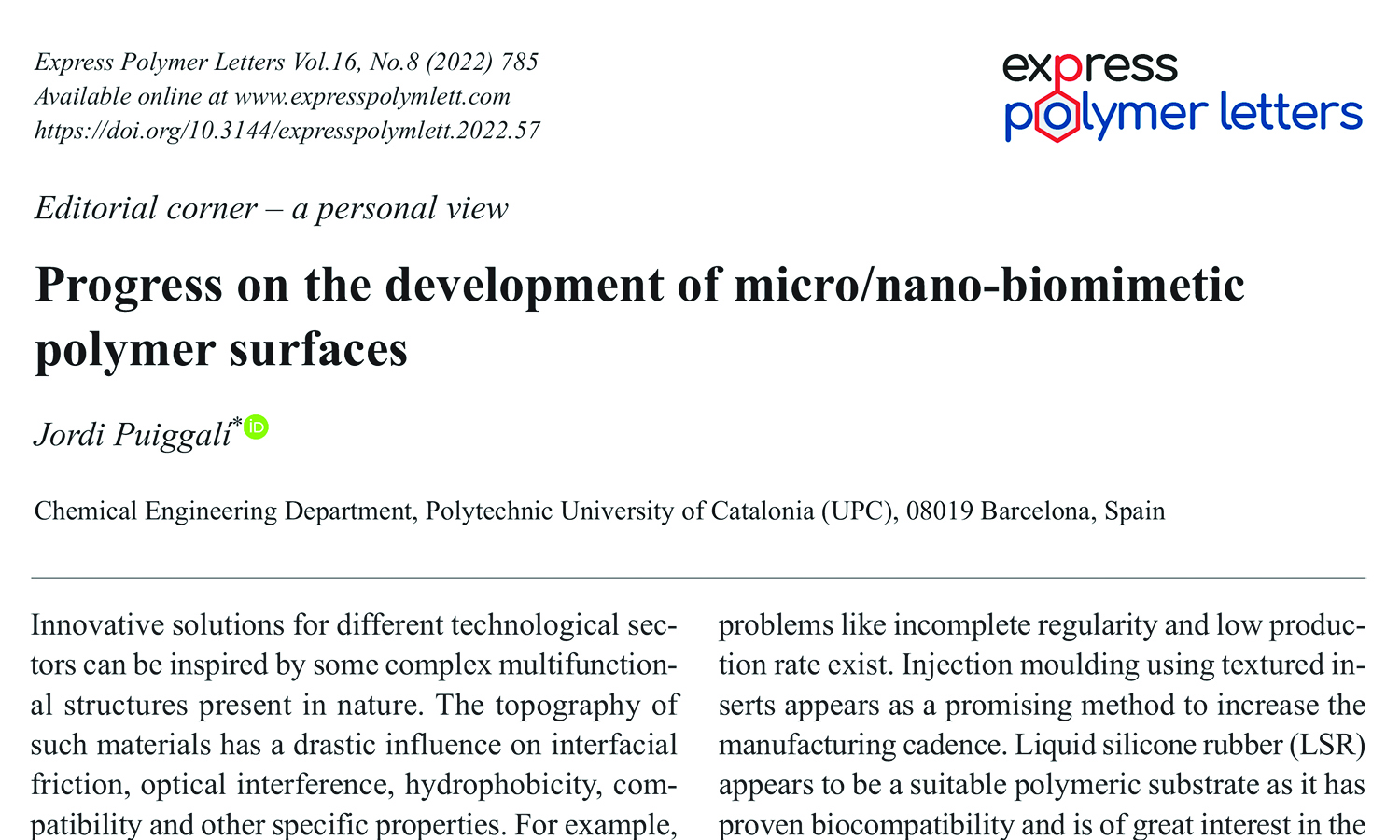
This is an editorial article. It has no abstract.
Sawsan Dacrory, Ahmed M. Saeed, Ragab E. Abouzeid
Vol. 16., No.8., Pages 786-797, 2022
DOI: 10.3144/expresspolymlett.2022.58
Vol. 16., No.8., Pages 786-797, 2022
DOI: 10.3144/expresspolymlett.2022.58
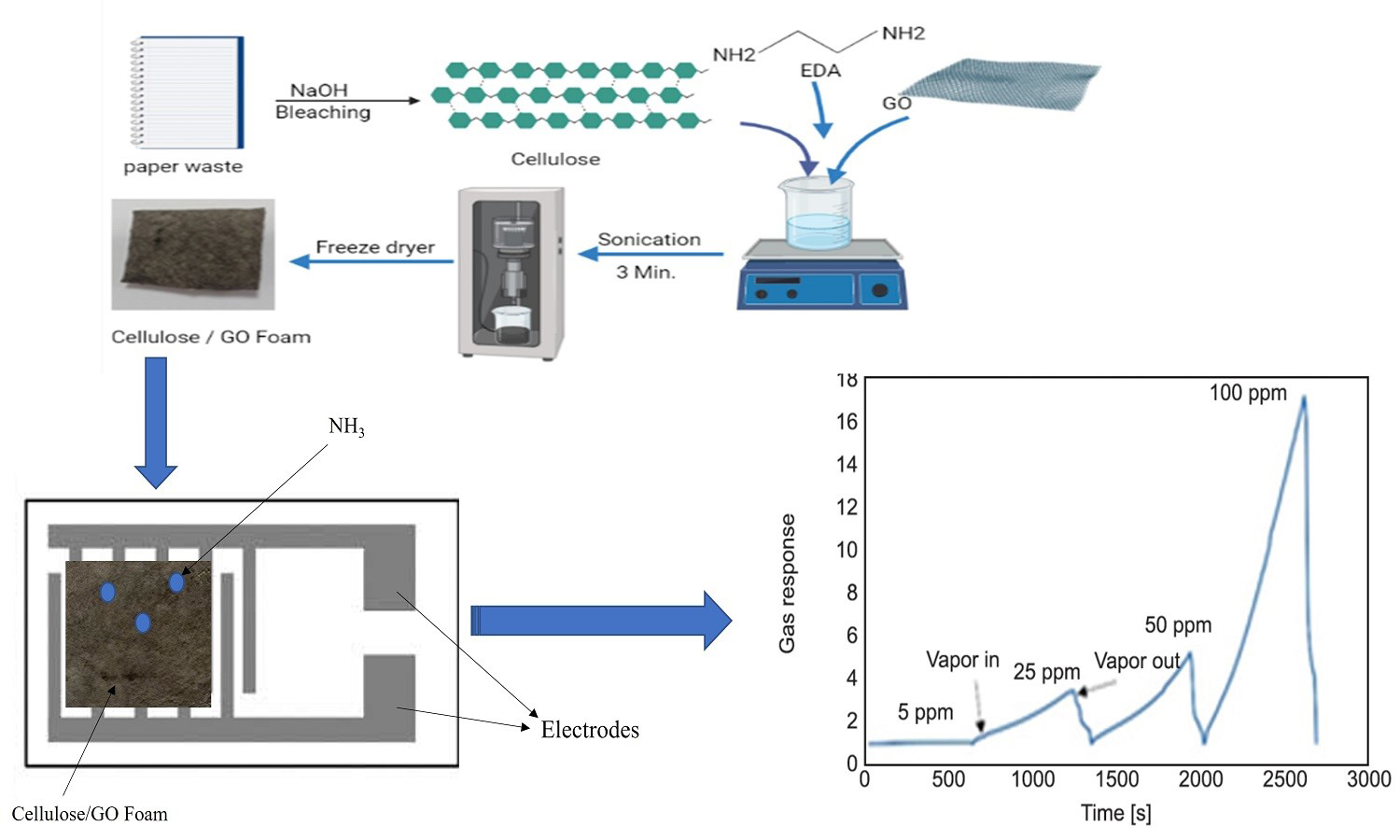
In this study eco-friendly cellulose/graphene oxide scaffold has been formulated in the presence of different ratios of ethylenediamine (EDA) as a crosslinker via a lyophilization instrument. Cellulose was extracted from paper wastes and companied with graphene oxide (GO). Chemical structure and surface morphology of the extracted cellulose and cellulose/GO foam were investigated by infrared spectroscopy (FTIR), X-ray diffraction (XRD), thermal gravimetric analysis (TGA), and the scanning electron microscope (SEM) techniques. The prepared cellulose/GO foam was used as a gas sensing material, including the sensitivity and response/recovery times toward NH3 vapor. The cellulose/GO cryogel which was prepared with the addition of 1.5 mmol of EDA showed the highest sensitivity at room temperature with the response and recovery times at 490 and 620 s, respectively, compared to the cryogel prepared with 2.25 mmol EDA and the pristine cellulose cryogel.
Klara Lysakova, Kristyna Hlinakova, Katerina Kutalkova, Radka Chaloupkova, Jan Zidek, Jana Brtnikova, Lucy Vojtova
Vol. 16., No.8., Pages 798-811, 2022
DOI: 10.3144/expresspolymlett.2022.59
Vol. 16., No.8., Pages 798-811, 2022
DOI: 10.3144/expresspolymlett.2022.59
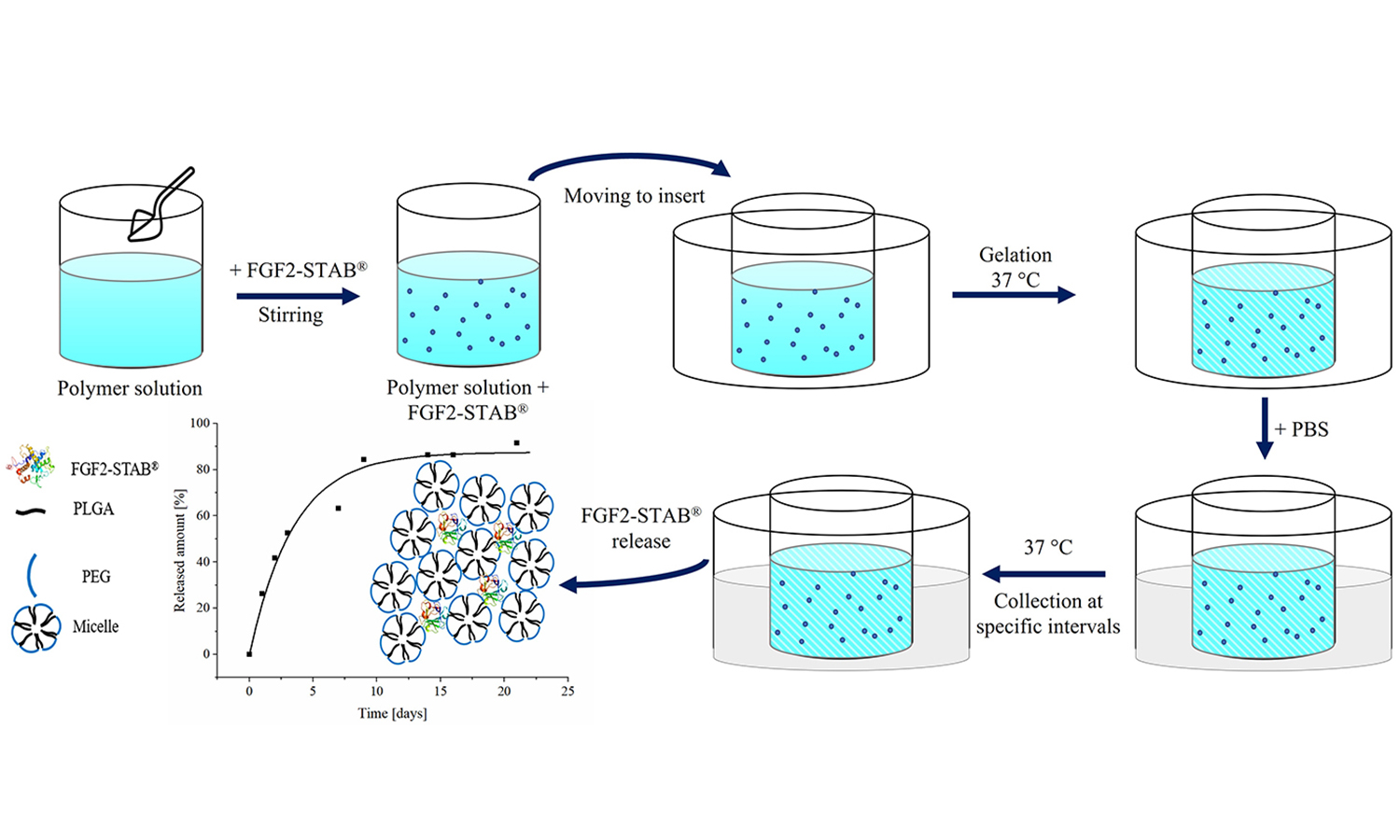
In recent times, autologous fat grafting has emerged as one of the most popular techniques for restoring volume depletion. Although the retention predictability of grafted fat has been improved, the quality of grafted tissue is still unsatisfactory. Unpredictable volume loss and low-fat survival is a major problem after application. Biodegradable PLGA-PEGPLGA (poly(lactic-co-glycolic acid)-b-poly(ethylene glycol)-b-poly(lactic-co-glycolic acid)) hydrogel delivery system enriched with stable fibroblast growth factor 2 (FGF2-STAB®), due to its properties, seems to be attractive material that will help to increase fat life. In this study, the mechanism of FGF2-STAB® release from an injectable thermosensitive and biodegradable PLGA-PEG-PLGA hydrogel was monitored. First-order kinetics were controlled mainly by decreasing the concentration of an active compound in the matrix and, at a later stage, by matrix degradation. Furthermore, the activity of the protein after release from the hydrogel matrix was studied. No loss of FGF2-STAB® activity in the dynamic system after 14 days has been detected. The development of such a drug delivery system appears promising for further use in reconstructive medicine e.g., in mixing with fat graft being the subject of current research.
Kriengsak Damampai, Skulrat Pichaiyut, Amit Das, Charoen Nakason
Vol. 16., No.8., Pages 812-826, 2022
DOI: 10.3144/expresspolymlett.2022.60
Vol. 16., No.8., Pages 812-826, 2022
DOI: 10.3144/expresspolymlett.2022.60
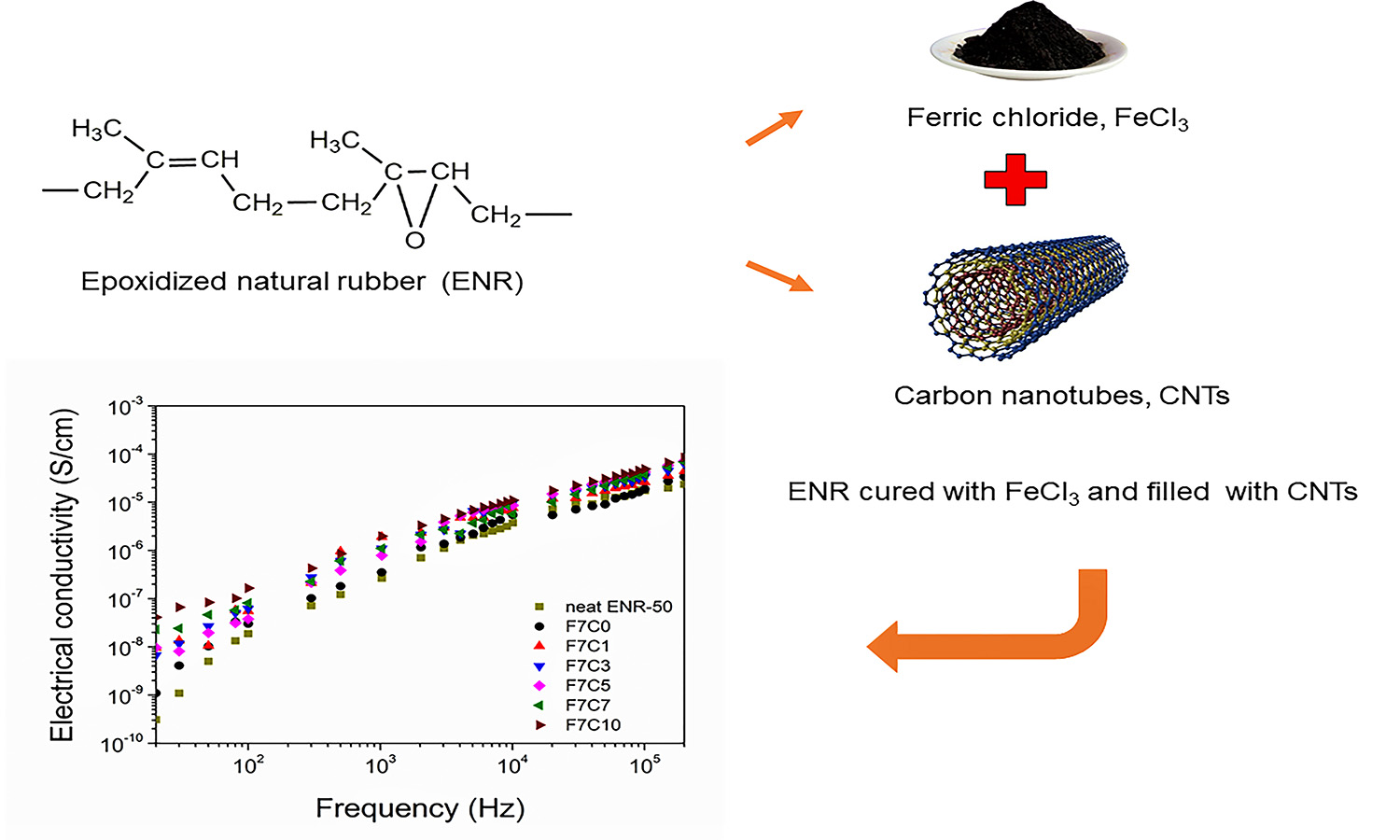
In this work, the crosslinking reaction of epoxidized natural rubber (50 mol% epoxy, ENR-50) by metal ion namely ferric ion (Fe3+, FeCl3, ferric chloride) was studied. It was found that a direct interaction of the ferric ion with the epoxy group as well as internal polymerization enable the ENR to be efficiently cured. The vulcanizing ENR-FeCl3 compound was then reinforced by carbon nanotubes (CNTs). The FTIR spectra of ENR-FeCl3 compounds without and with CNTs show the absorption peak at the wavenumber 470 cm–1, which represents the –O–Fe–O– linkages from a reaction of FeCl3 and opened oxirane ring products of ENR molecules. Furthermore, the ENR-FeCl3 compounds show a typical marching curing curve with a steady increase in torque as increasing of the testing time; especially the effect is more pronounced in CNTs filled system. Furthermore, an increase in the concentration of CNTs causes increasing in torque difference and enhancement of the mechanical properties (i.e., 100% moduli and tensile strength). The SEM micrograph shows good compatibility between CNTs and the rubber matrix in the ENR-FeCl3 compounds. Also, the electrical conductivities of ENR-FeCl3/CNTs nanocomposite increases with the increase of CNTs loading. It is also observed that the degradation temperature (Td) of ENR-FeCl3/CNTs is shifted toward a higher temperature range with the increase of the CNTs loadings.
Suchawadee Saisangtham, Chutiwat Likitaporn, Pornnapa Kasemsiri, Jiaqian Qin, Manunya Okhawilai, Pranut Potiyaraj, Hiroshi Uyama
Vol. 16., No.8., Pages 827-845, 2022
DOI: 10.3144/expresspolymlett.2022.61
Vol. 16., No.8., Pages 827-845, 2022
DOI: 10.3144/expresspolymlett.2022.61
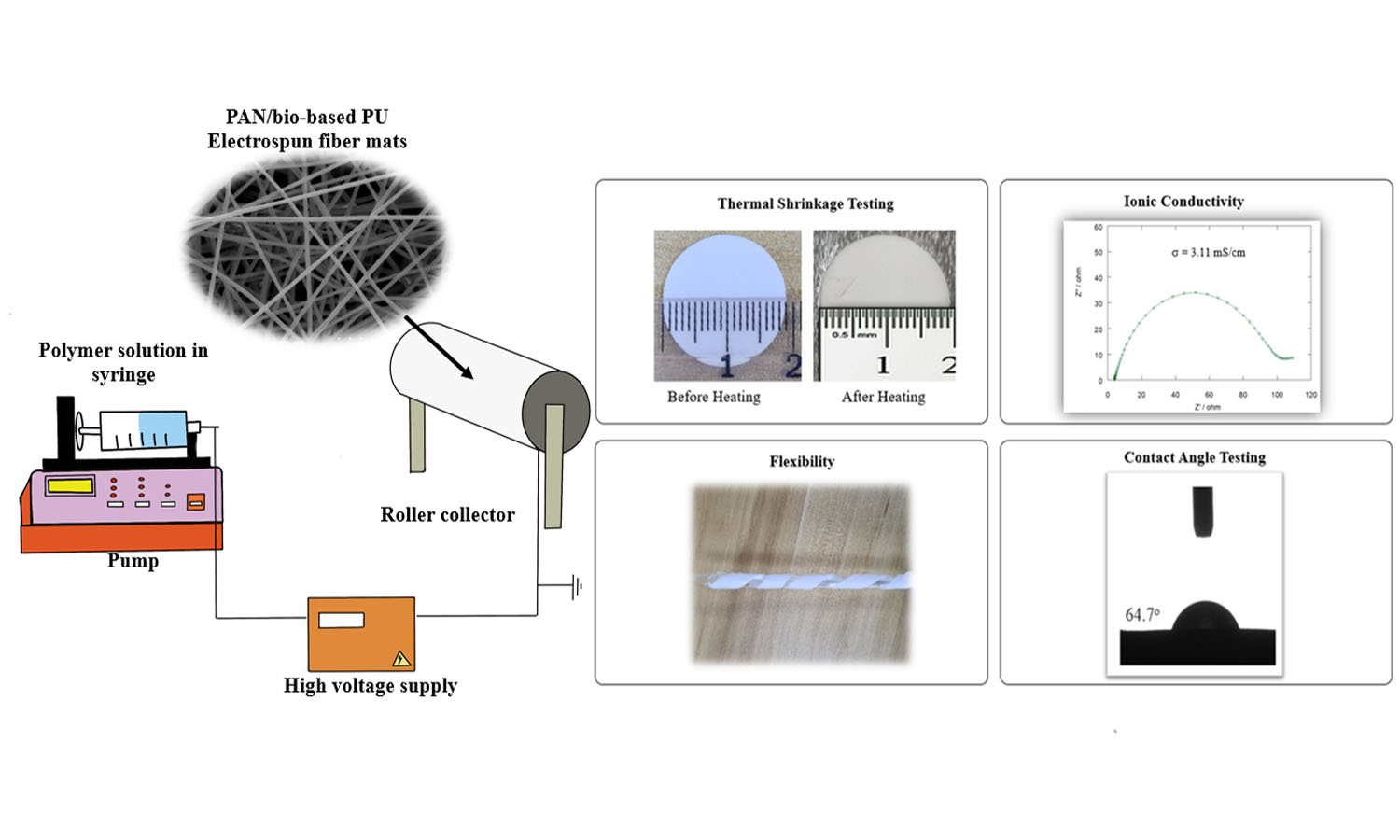
This research aims to fabricate a polyacrylonitrile (PAN)/bio-based polyurethane (bio-based PU) separator for a Zn-ion battery. PAN/bio-based PU electrospun fiber mats at 75/25 were prepared via electrospinning technique using Taguchi experimental design with three parameters and four levels. It was found that all fiber mats illustrated smooth and continuous fiber. The properties of the electrospun fiber mats were optimized in accordance with the grey relational method. Furthermore, the fiber mats prepared from 14 wt% polymer concentration, 25 kV of applied voltage, and 16 cm of distance from tip to collector were determined to be the most suitable fabrication condition exhibiting an ionic conductivity of 3.11 mS/cm, the tensile strength of 44.16 MPa, and electrolyte uptake of 1,971%. Moreover, the fiber mats showed no dimensional change at a temperature of 150°C because of the incorporation of bio-based PU in the polymer network. The electrochemical stability of the Zn-ion battery with the developed separator was greater than that of the commercial glass fiber separator. Thus, the PAN/bio-based PU electrospun fiber can be considered a promising candidate as a separator for Zn-ion batteries.
Alexander N. Tarasenkov, Maria S. Parshina, Nadezhda A. Tebeneva, Kirill M. Borisov, Galina P. Goncharuk, Vitaliy G. Shevchenko, Sergey A. Ponomarenko, Aziz M. Muzafarov
Vol. 16., No.8., Pages 846-870, 2022
DOI: 10.3144/expresspolymlett.2022.62
Vol. 16., No.8., Pages 846-870, 2022
DOI: 10.3144/expresspolymlett.2022.62
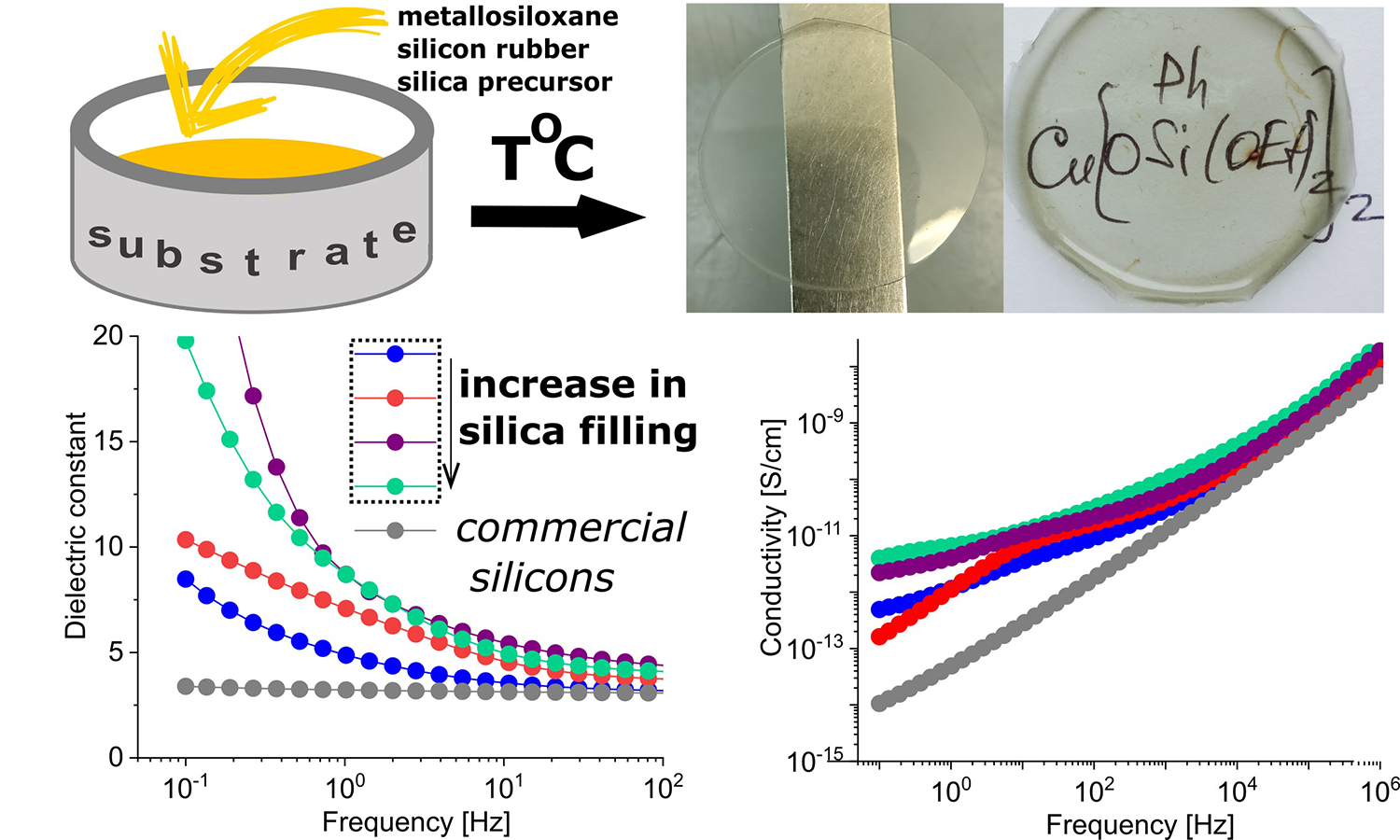
The dielectric and mechanical properties of a wide range of polydimethylsiloxane-based compositions filled with silica component and cured with various metallosiloxanes have been studied. It is shown that the resulting systems are typical dielectrics. Silica component introduction in combination with the metal-siloxane network formation in the material can significantly increase its dielectric permittivity and conductivity in the frequency range <102 Hz compared to commercial silicon compounds and pure PDMS. It is found that varying the metallosiloxane structure and composition and the degree of silica filling are effective tools for changing the dielectric parameters of the material - up to ~5–10 at 1–10 Hz. By varying the functionality and length of the rubber chain, as well as the curing rate, it is possible to vary the mechanical properties of the material within a wide range – 2–10 MPa strength and elongation up to 500% with the pure elastomeric properties up to 200%. This approach to the formation of material opens up prospects for using such cured systems as dielectric elastomers for special applications such as flexible capacitive sensors or actuators for medical and robotic applications.
Rawiporn Promsung, Yeampon Nakaramontri, Claudia Kummerloewe, Jobish Johns, Norbert Vennemann, Ekwipoo Kalkornsurapranee
Vol. 16., No.8., Pages 871-880, 2022
DOI: 10.3144/expresspolymlett.2022.63
Vol. 16., No.8., Pages 871-880, 2022
DOI: 10.3144/expresspolymlett.2022.63
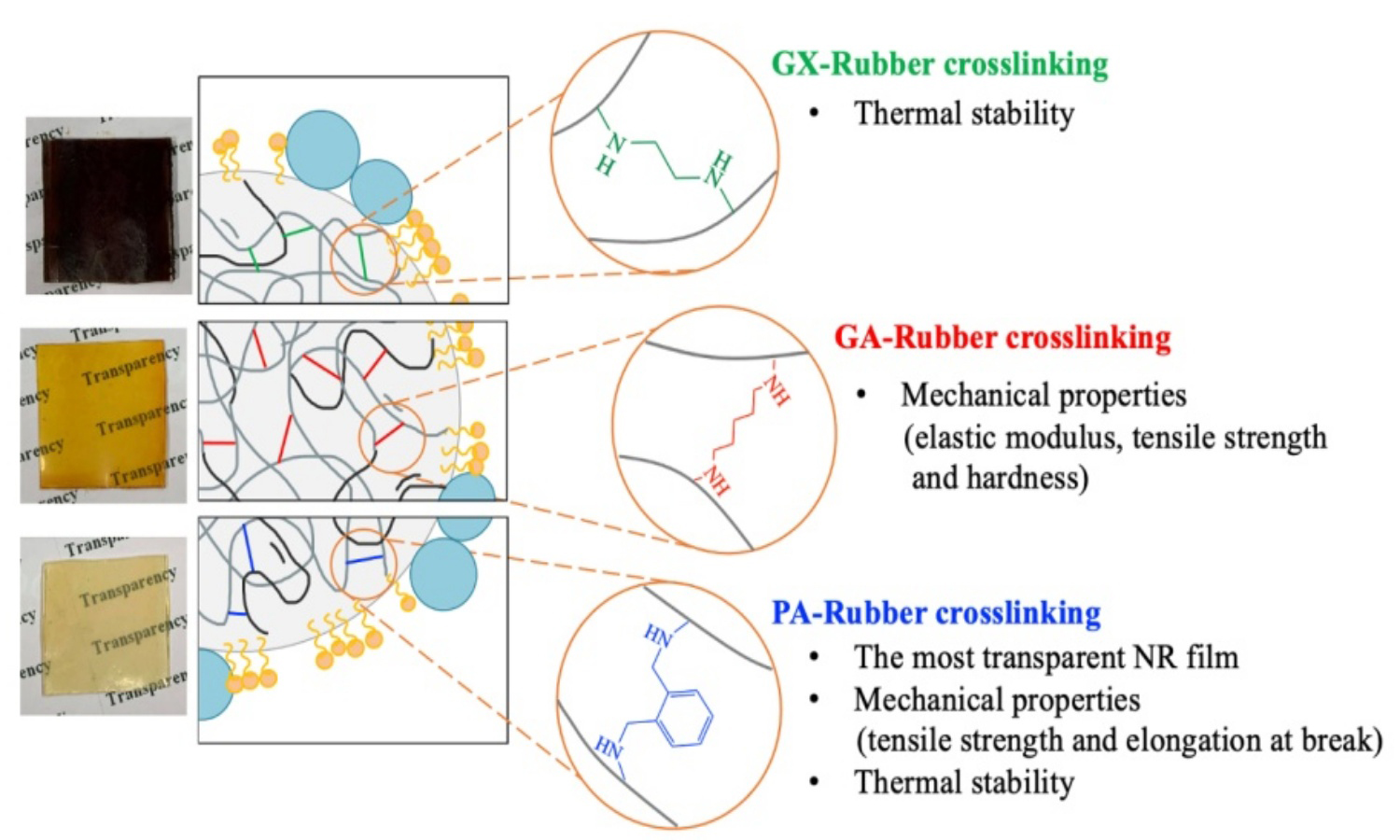
A new simple system to vulcanize natural rubber (NR) latex at low temperature (50°C) using different bifunctional aldehydes has been proposed. Bifunctional aldehydes with different number of carbon atoms present in the chemical structure, including glyoxal (GX) with 2 carbon atoms, glutaraldehyde (GA) with 5 carbon atoms and phthaldialdehyde (PA) with 8 carbon atoms were added into natural rubber latex. The mechanical, thermal and optical properties of the crosslinked NR were studied. The formation of crosslinking in the cured NRs was confirmed using infrared spectroscopy (ATR-FTIR). A new absorption peak was found at 1589 cm–1 for ‒NH bending of secondary amine in the case of cured NRs when compared to uncured NR. Universal testing machine (UTM), dynamic mechanical thermal analysis (DMA), thermogravimetric analyzer (TGA) and temperature scanning stress relaxation (TSSR) were employed to study the tensile and thermal properties of cured NRs. Results revealed that the GA cured NR exhibited superior mechanical properties in terms of 100% modulus, tensile strength and hardness up to 2.13, 6.38 MPa and 54.67 Shore A, respectively. Furthermore, GA cured NR showed the highest crosslink density (72.40 mol/m3) and also showed better thermal properties among the different curing systems. The optical properties in terms of transparency of cured NRs were studied. It was noticed that PA cured NR gave more transparency and hence it can be introduced in developing materials for sensor applications.
Marina Patricia Arrieta, Freddys Beltran, Sara Soledad Abarca de las Muelas, Gerald Gaspar, Rafael Sanchez Hernandez, Maria Ulagares de la Orden, Joaquin Martinez Urreaga
Vol. 16., No.8., Pages 881-900, 2022
DOI: 10.3144/expresspolymlett.2022.64
Vol. 16., No.8., Pages 881-900, 2022
DOI: 10.3144/expresspolymlett.2022.64
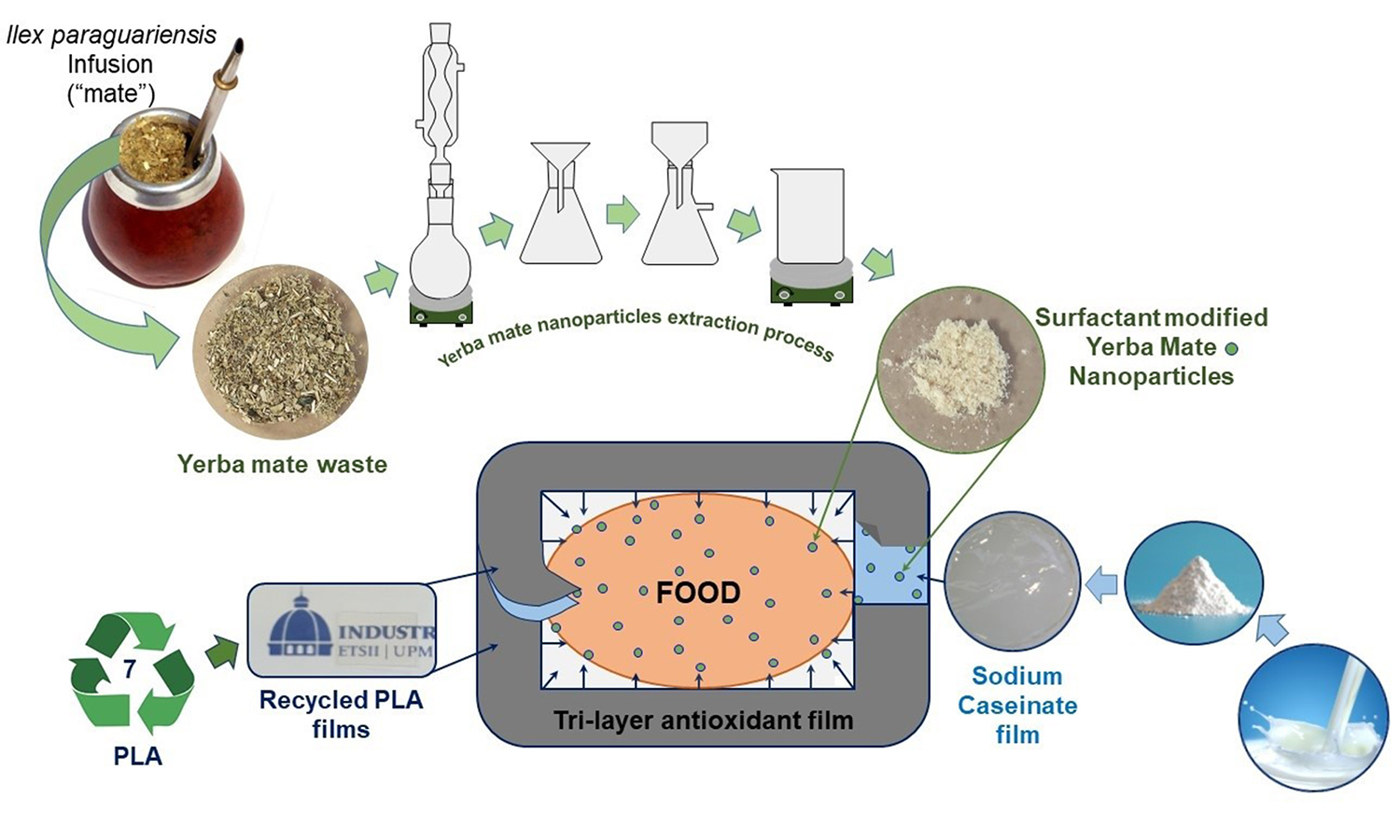
Tri-layer films based on glycerol-plasticized sodium caseinate film (SC) as the middle layer and two outer layers of mechanically recycled poly(lactic acid) (RPLA) were successfully developed. Additionally, the internal RPLA-based layer was loaded either with 1 or 3 wt% of lignocellulose nanoparticles extracted from yerba mate waste (YMNs) to obtain antioxidant-active packaging formulations. YMNs were also surface modified with a surfactant to increase the interfacial adhesion and improve their dispersion into the polymeric matrix. The tri-layer system composed of YMNs loaded nanocomposites (RPLA/SC/RPLA-YMN1 and RPLA/SC/RPLA-YMN3) exhibited an improved oxygen barrier compared to the nonreinforced system counterpart (RPLA/SC/RPLA). The high water vapor permeability of SC was reduced in tri-layer systems, ascribed to the protection of the middle SC layer by the hydrophobic RPLA layers at both sides. The improved performance of all these properties was ascribed to the good adhesion between PLA and SC layers, ascribed to hydrogen bonding interactions. Furthermore, the obtained tri-layer structures showed effective antioxidant ability for fatty food, as it was demonstrated by release studies conducted in a fatty food simulant and further analysis of the radical-scavenging activity showing good antioxidant properties (RPLA/SC/RPLA-YMN1 = 36.8±2.5 GA mg/dm2 film and RPLA/SC/RPLA-YMN3 = 81.1±2.5 Gallic Acid mg/dm2 film). Finally, the tri-layer films were disintegrated under composting conditions in 17 days. Thus, the results show the potential of the mechanical recycling process of PLA as a sustainable alternative to revalorizing PLA waste, while the revalorization of yerba mate waste shows its interest by easily providing the materials with antioxidant properties. Finally, the tri-layer bio-based and biodegradable active formulations resulted in interesting materials for fatty foodstuffs.


